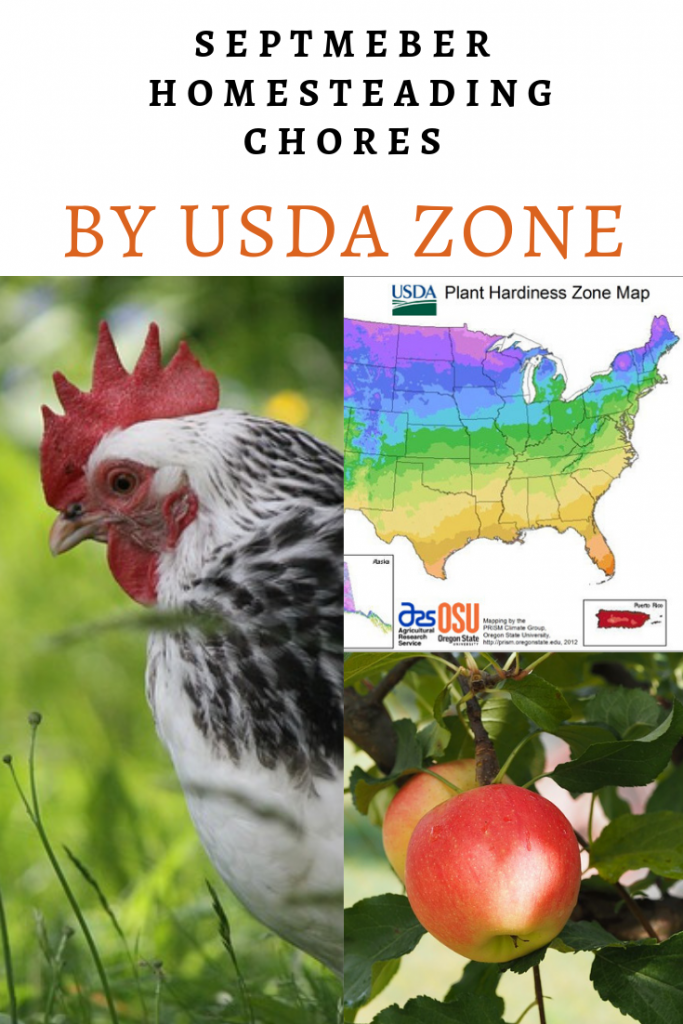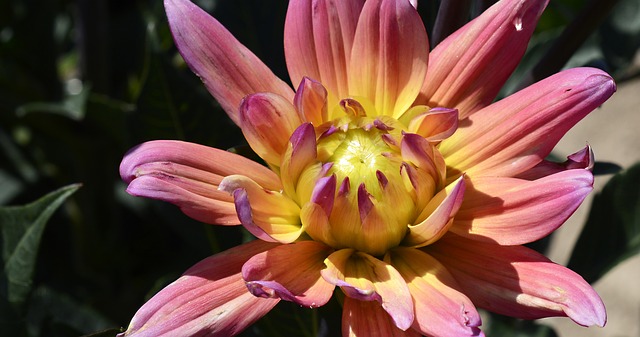
September Homesteading Chores
These homesteading chores are intended as a general guideline. Most homesteaders will need to adjust their activities according to their local climate and conditions. For information tailored to your area, consult your local extension office.
Find Your Zone… Click on the link to see your average first and last frost dates.
This post contains affiliate links. You will not pay extra for products purchased through those links, but we may earn a small commission from the sale.
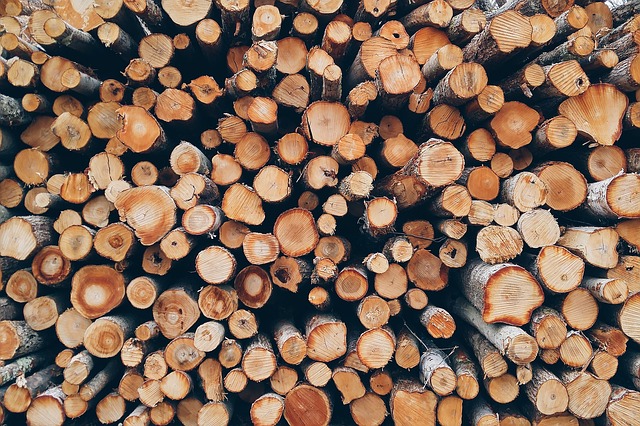
USDA Zone 1
Average Low Temperatures:
- -60 to -55F in zone 1a
- -55 to -50F in zone 1b
September Homesteading – Farm Chores
- Allow livestock out on pasture during the day
- Make sure chicken coop and barn are ready for winter
- Use deep litter bedding method to heat the barn for winter
- Finish putting up livestock feed for winter
- Assess feed supplies to ensure they will last through winter
- Butcher or sell extra livestock
- Check fence lines for damage and signs of predators
- Cut, split, and store firewood
As an Amazon affiliate, I earn a commission from qualifying purchases.
September Homesteading – Garden Chores
- Tend to your cool-season crops in cold frames
- Be prepared to cover cold frames when a hard freeze threatens
- Clean out tool shed for winter storage
- Make sure garden hoses and tools are cleaned and put away for winter
- Clean out the greenhouse and prepare it for winter
- Water new trees, shrubs, and perennials when the weather is dry
- Treat tender evergreens with anti-desiccants
- Preserve the harvest for winter
- Store crops in the root cellar and check often for signs of decay

USDA Zone 2
Average Low Temperatures:
- -50 to -45F in zone 2a
- -45 to -30F in zone 2b
September Homesteading – Farm Chores
- Allow livestock out on pasture when the weather allows
- Finish preparing chicken coop and barn for winter
- Begin deep litter bedding method to heat the barn for winter
- Finish putting up livestock feed for winter
- Assess feed supplies to ensure they will last through winter
- Butcher or sell extra livestock
- Check fence lines for damage and signs of predators
- Cut, split, and store firewood
- Work on building projects when the weather allows
As an Amazon affiliate, I earn a commission from qualifying purchases.
September Homesteading – Garden Chores
- Tend to your cool-season crops in cold frames
- Be prepared to cover cold frames when a hard freeze threatens
- Clean out tool shed for winter storage
- Make sure garden hoses and tools are cleaned and put away for winter
- Clean out the greenhouse and prepare it for winter
- Water new trees, shrubs, and perennials when the weather is dry
- Treat tender evergreens with anti-desiccants
- Preserve the harvest for winter
- Store crops in the root cellar and check often for signs of decay
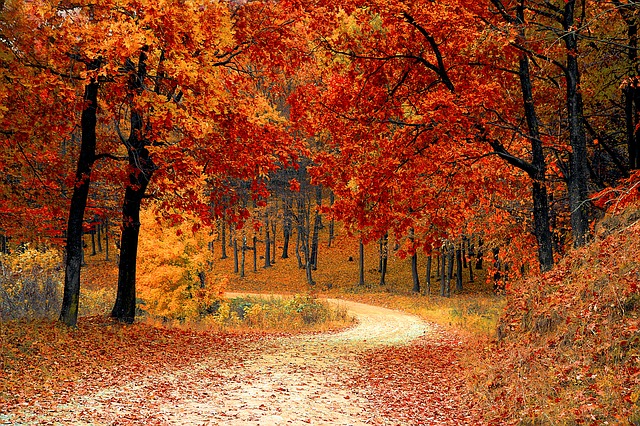
USDA Zone 3
Average Low Temperatures:
- -40 to -35F in zone 3a
- -35 to -30F in zone 3b
September Homesteading – Farm Chores
- Allow livestock out on pasture when the weather allows
- Finish preparing chicken coop and barn for winter
- Begin deep litter bedding method to heat the barn for winter
- Finish putting up livestock feed for winter
- Assess feed supplies to ensure they will last through winter
- Finish harvesting grain crops when the weather allows
- Butcher or sell extra livestock
- Check fence lines for damage and signs of predators
- Cut, split, and store firewood
- Work on building projects when the weather allows
As an Amazon affiliate, I earn a commission from qualifying purchases.
September Homesteading – Garden Chores
- Tend to your cool-season crops in cold frames
- Clean out tool shed for winter storage
- Make sure garden hoses and tools are cleaned and put away for winter
- Clean out the greenhouse and prepare it for winter
- Water new trees, shrubs, and perennials as needed
- Harvest fruits and vegetables as they ripen
- Cover tender crops when frost threatens
- Begin storing crops in the root cellar and check often for signs of decay
- Mulch garden crops, trees, shrubs, perennials, and annuals to prevent moisture loss from soil
- Water newly planted trees, shrubs, and perennials as needed
- Preserve the harvest
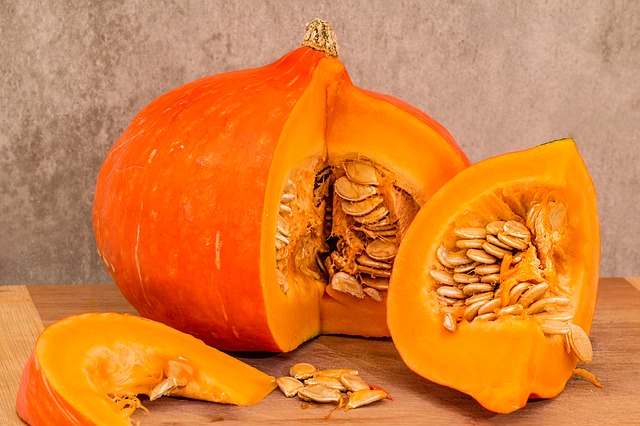
USDA Zone 4
Average Low Temperatures:
- -30 to -25F in zone 4a
- -25 to -20F in zone 4b
September Homesteading – Farm Chores
- Allow livestock out on pasture
- Prepare chicken coop and barn for winter
- Consider using deep litter bedding method to heat the barn for winter
- Put up livestock feed for winter
- Assess feed supplies to ensure they will last through winter
- Begin to butcher or sell extra livestock
- Check fence lines for damage and signs of predators
- Harvest field crops as they ripen and weather allows
- Cut, split, and store firewood
- Work on building projects when the weather allows
As an Amazon affiliate, I earn a commission from qualifying purchases.
September Homesteading – Garden Chores
- Tend to your cool-season crops in cold frames
- Clean out tool shed for winter storage
- Make sure garden hoses and tools are cleaned and put away for winter
- Clean out the greenhouse and prepare it for winter
- Cultivate and irrigate garden crops as needed
- Water new trees, shrubs, and perennials as needed
- Harvest fruits and vegetables as they ripen
- Mulch garden crops, trees, shrubs, perennials, and annuals to prevent moisture loss from soil
- Water newly planted trees, shrubs, and perennials as needed
- Preserve the harvest
- Cover tender crops when frost threatens
- Begin storing crops in the root cellar and check often for signs of decay

USDA Zone 5
Average Low Temperatures:
- -20 to -15F in zone 5a
- -15 to -10F in zone 5b
September Homesteading – Farm Chores
- Allow livestock out on pasture
- Watch for hot spells and cold snaps this month
- Prepare chicken coop and barn for winter
- Consider using deep litter bedding method to heat the barn for winter
- Put up livestock feed for winter
- Assess feed supplies to ensure they will last through winter
- Begin to butcher or sell extra livestock
- Check fence lines for damage and signs of predators
- Harvest field crops as they ripen and weather allows
- Cut, split, and store firewood
- Work on building projects when the weather allows
As an Amazon affiliate, I earn a commission from qualifying purchases.
September Homesteading – Garden Chores
- Tend to your cool-season crops in cold frames
- Clean out tool shed for winter storage
- Make sure garden hoses and tools are cleaned and put away for winter
- Clean out the greenhouse and prepare it for winter
- Cultivate and irrigate garden crops as needed
- Water new trees, shrubs, and perennials as needed
- Harvest fruits and vegetables as they ripen
- Mulch garden crops, trees, shrubs, perennials, and annuals to prevent moisture loss from soil
- Water newly planted trees, shrubs, and perennials as needed
- Preserve the harvest
- Cover tender crops when frost threatens
- Begin storing crops in the root cellar and check often for signs of decay
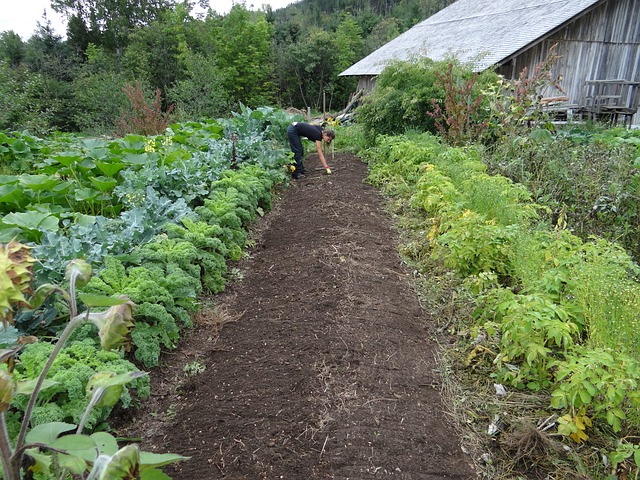
USDA Zone 6
Average Low Temperatures:
- -10 to -5F in zone 6a
- -5 to 0F in zone 6b
September Homesteading – Farm Chores
- Allow livestock out on pasture
- Watch for hot spells and cold snaps this month
- Begin preparing chicken coop and barn for winter
- Put up livestock feed for winter
- Bale last of hay if the weather allows
- Assess feed supplies to ensure they will last through winter
- Begin to butcher or sell extra livestock
- Check fence lines for damage and signs of predators
- Harvest field crops as they ripen and weather allows
- Cut, split, and store firewood
- Work on building projects when the weather allows
As an Amazon affiliate, I earn a commission from qualifying purchases.
September Homesteading – Garden Chores
- Tend to your cool-season crops in cold frames
- Harvest fruits and vegetables
- Preserve the harvest
- Clean out tool shed for winter storage
- Begin cleaning and storing garden hoses and tools for winter
- Clean out the greenhouse and prepare it for winter
- Mulch garden crops, trees, shrubs, perennials, and annuals to prevent moisture loss from soil
- Cultivate and irrigate garden crops as needed
- Cover tender crops when frost threatens
- Water newly planted trees, shrubs, and perennials as needed
- Move potted herbs and houseplants indoors to acclimate for the winter
- Watch for signs of disease and pests in fruits and vegetables and treat when needed
- Clean out the root cellar and prepare to store the harvest
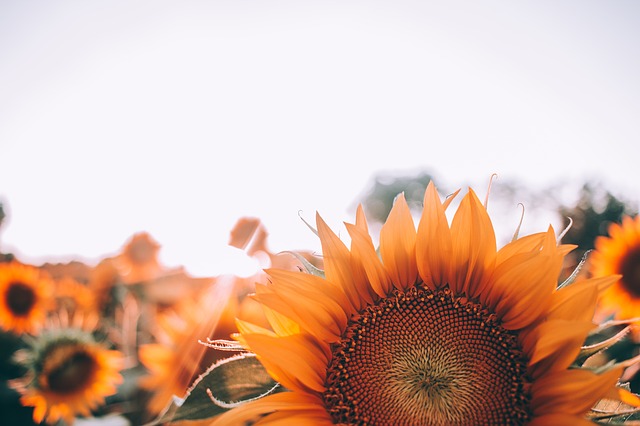
USDA Zone 7
Average Low Temperatures:
- 0 to 5F in zone 7a
- 5 to 10F in zone 7b
September Homesteading – Farm Chores
- Allow livestock out on pasture
- Begin preparing chicken coop and barn for cold weather
- Put up livestock feed for winter
- Bale hay if the weather allows
- Assess feed supplies to ensure they will last through winter
- Prepare to butcher or sell extra livestock
- Check fence lines for damage and signs of predators
- Harvest field crops as they ripen and weather allows
- Cut, split, and store firewood
- Work on building projects when the weather allows
As an Amazon affiliate, I earn a commission from qualifying purchases.
September Homesteading – Garden Chores
- Tend to your cool-season crops in the garden
- Transplant cool-season seedlings into a cold frame to extend the growing season
- Harvest fruits and vegetables
- Preserve the harvest
- Clean out tool shed for winter storage
- Begin cleaning and storing garden hoses and tools for winter
- Clean out the greenhouse and prepare it for winter
- Mulch garden crops, trees, shrubs, perennials, and annuals to prevent moisture loss from soil
- Cultivate and irrigate garden crops as needed
- Cover tender crops if an early frost threatens
- Water newly planted trees, shrubs, and perennials as needed
- Prepare potted herbs and houseplants for moving indoors
- Watch for signs of disease and pests in fruits and vegetables and treat when needed
- Clean out the root cellar and prepare to store the harvest

USDA Zone 8
Average Low Temperatures:
- 10 to 15F in zone 8a
- 15 to 20F in zone 8b
September Homesteading – Farm Chores
- Pasture livestock
- Provide livestock with shade and extra water in hot weather
- Poultry need shade and extra water in hot weather to continue laying eggs
- Check livestock for signs of heat distress
- Put up livestock feed for winter
- Put up hay as weather allows
- Harvest field crops as they ripen and weather allows
- Check field crops for insect damage, treat as necessary
- Cut, split, and store firewood
- Work on building projects when the weather allows
- Plant cool-season fodder crops
- Prepare to butcher or sell extra livestock
- Check fence lines for damage and signs of predators
As an Amazon affiliate, I earn a commission from qualifying purchases.
September Homesteading – Garden Chores
- Transplant cool-season vegetables into cold frames to extend the season
- Tend cool-season crops in the garden
- Harvest warm-season vegetables
- Preserve the harvest
- Water newly planted fruit trees, shrubs, hardy perennials, and roses
- Provide extra water for all crops in drought conditions
- Mulch plants to prevent moisture loss from soil
- Prepare potted herbs and houseplants for moving indoors
- Watch for signs of disease and pests in fruits and vegetables and treat when needed

USDA Zone 9
Average Low Temperatures:
- 20 to 25F in zone 9a
- 25 to 30F in zone 9b
September Homesteading – Farm Chores
- Pasture livestock
- Provide livestock with shade and extra water in hot weather
- Poultry need shade and extra water in hot weather to continue laying eggs
- Harvest field crops as they ripen and weather allows
- Cultivate and irrigate field crops as needed
- Check crops for insect damage, treat as necessary
- Prepare beds and plant cool-season fodder crops
- Work on building projects when the weather allows
- Prepare beds to plant cool-season fodder crops
As an Amazon affiliate, I earn a commission from qualifying purchases.
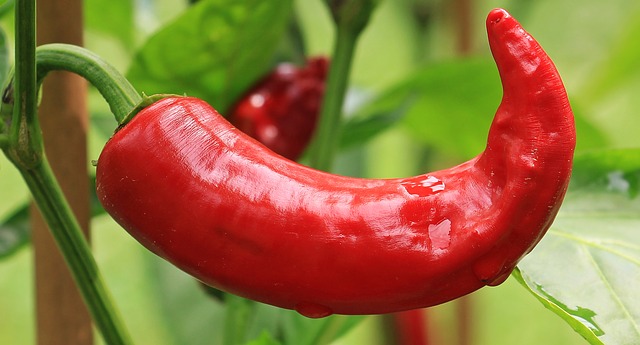
September Homesteading – Garden Chores
- Transplant vegetables for your fall garden
- Direct seed cool-season crops in the garden
- Tend and harvest warm-season vegetables
- Preserve the harvest
- Water newly planted fruit trees, shrubs, hardy perennials, and roses
- Provide extra water for all crops in drought
- Mulch plants to prevent moisture loss from soil
- Grow herbs and houseplants in a shady spot outdoors
- Watch for signs of disease and pests in fruits and vegetables and treat when needed
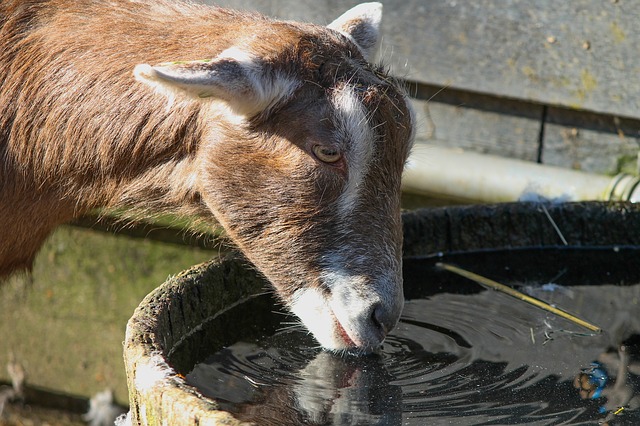
USDA Zone 10
Average Low Temperatures:
- 30 to 35F in zone 10a
- 35 to 40F in zone 10b
September Homesteading – Farm Chores
- Provide livestock with shade and extra water in hot weather
- Poultry need shade and extra water in hot weather to continue laying eggs
- Check livestock often for signs of heat distress
- Cultivate and irrigate field crops as needed
- Harvest field crops as they ripen and the weather allows
- Check field crops for insect damage, treat as necessary
- Work on building projects when the weather allows
- Prepare beds and plant cool-season fodder crops
As an Amazon affiliate, I earn a commission from qualifying purchases.
September Homesteading – Garden Chores
- Direct seed vegetables for your fall garden
- Tend and harvest warm-season vegetables
- Preserve the harvest
- Water newly planted fruit trees, shrubs, hardy perennials, and roses
- Provide extra water for all crops in drought
- Protect crops with shade cloth when needed
- Check citrus trees for pests
- Water citrus trees, fruit trees, shrubs, hardy perennials, and vegetable garden as needed
- Move herbs and houseplants to shady spots and water often in the heat or move indoors
- Watch for signs of disease and pests in fruits and vegetables and treat when needed
USDA Zone 11
Average Low Temperatures:
- 40 to 45F for zone 11a
- 45 to 50F for zone 11b
September Homesteading – Farm Chores
- Provide livestock with shade and extra water in hot weather
- Poultry need shade and extra water in hot weather to continue laying eggs
- Check livestock often for signs of heat distress
- Cultivate and irrigate field crops as needed
- Harvest field crops as they ripen and the weather allows
- Check field crops for insect damage, treat as necessary
- Work on building projects when the weather allows
- Order seed and prepare beds for cool-season fodder crops
As an Amazon affiliate, I earn a commission from qualifying purchases.
September Homesteading – Garden Chores
- Direct seed vegetables for your fall garden
- Start seeds for herbs and cool-season crops indoors to transplant in fall
- Harvest vegetables and preserve
- Water and weed herbs, vegetables and flowers in garden beds
- Water newly planted citrus, mangoes, avocados, and papayas as needed
- Water, weed and mulch beds
- Check citrus trees for pests
- Grow herbs and houseplants in shade and water often in drought, or move indoors
- Watch for signs of disease and pests in fruits and vegetables and treat when needed
- Fertilize citrus fruits, avocadoes, and papayas
Notes: Within each USDA Zone, there are many different micro-climates and variations in frost-free dates, average low temperatures, and average high temperatures. Visit the Interactive USDA Zone Map for the most accurate information about your local conditions.
The information listed here is intended to give a general guideline to appropriate homesteading activities for your area. Each individual using these guidelines must determine if the information is accurate for their conditions.
As an Amazon affiliate, I earn a commission from qualifying purchases.
